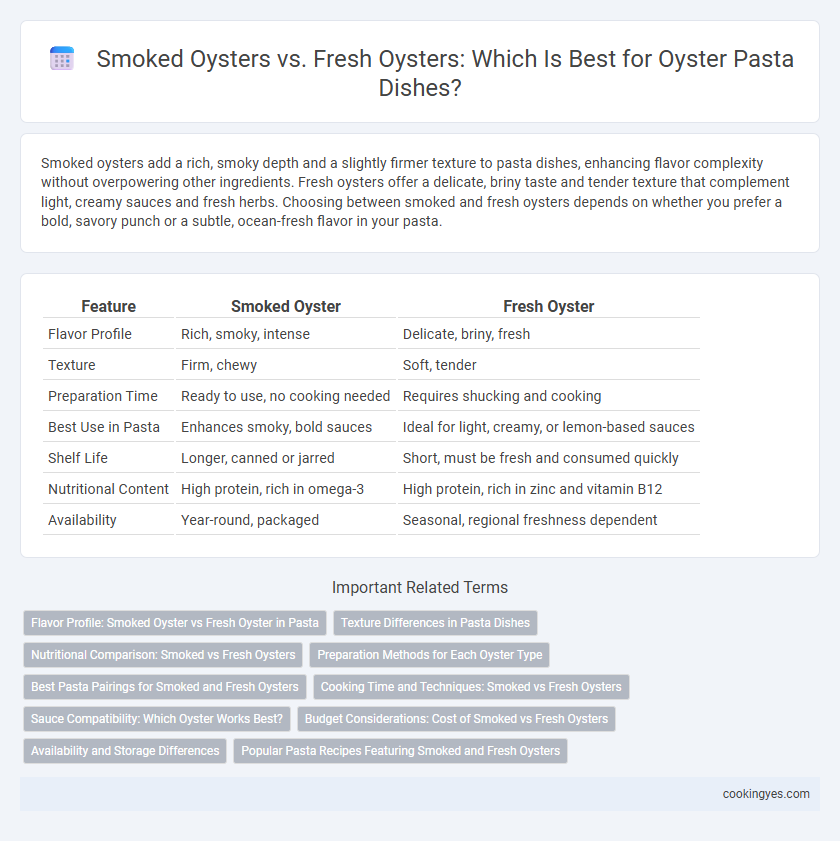Smoked oysters add a rich, smoky depth and a slightly firmer texture to pasta dishes, enhancing flavor complexity without overpowering other ingredients. Fresh oysters offer a delicate, briny taste and tender texture that complement light, creamy sauces and fresh herbs. Choosing between smoked and fresh oysters depends on whether you prefer a bold, savory punch or a subtle, ocean-fresh flavor in your pasta.
Table of Comparison
| Feature | Smoked Oyster | Fresh Oyster |
|---|---|---|
| Flavor Profile | Rich, smoky, intense | Delicate, briny, fresh |
| Texture | Firm, chewy | Soft, tender |
| Preparation Time | Ready to use, no cooking needed | Requires shucking and cooking |
| Best Use in Pasta | Enhances smoky, bold sauces | Ideal for light, creamy, or lemon-based sauces |
| Shelf Life | Longer, canned or jarred | Short, must be fresh and consumed quickly |
| Nutritional Content | High protein, rich in omega-3 | High protein, rich in zinc and vitamin B12 |
| Availability | Year-round, packaged | Seasonal, regional freshness dependent |
Flavor Profile: Smoked Oyster vs Fresh Oyster in Pasta
Smoked oysters impart a rich, smoky, and slightly salty flavor to pasta dishes, enhancing umami depth and adding a robust, savory character that complements creamy or tomato-based sauces. Fresh oysters offer a delicate, briny, and subtly sweet taste, providing a lighter, more oceanic essence ideal for dishes aiming for freshness and subtlety. Choosing between smoked and fresh oysters depends on the desired flavor intensity and complexity in the pasta preparation.
Texture Differences in Pasta Dishes
Smoked oysters bring a firm, chewy texture to pasta dishes, offering a rich, smoky flavor that contrasts with the tender, silky texture of fresh oysters. Fresh oysters maintain a delicate, buttery smoothness that blends seamlessly into creamy sauces, enhancing the overall mouthfeel without overpowering other ingredients. Choosing between smoked and fresh oysters affects the pasta's texture profile, with smoked oysters adding a robust, meaty bite and fresh oysters providing a gentle, melt-in-the-mouth sensation.
Nutritional Comparison: Smoked vs Fresh Oysters
Smoked oysters contain higher sodium levels due to the curing process, while fresh oysters provide more natural minerals such as zinc, iron, and vitamin B12. Fresh oysters are lower in calories and fat compared to smoked varieties, making them a lighter option for pasta dishes. The smoking process reduces some vitamin content but enhances flavor, creating a nutrient-dense and savory component that complements pasta recipes.
Preparation Methods for Each Oyster Type
Smoked oysters bring a rich, intense flavor and firm texture, often requiring minimal cooking and can be added directly to pasta for a smoky depth. Fresh oysters demand gentle shucking and a brief cook, like steaming or lightly sauteing, to preserve their delicate briny taste and tender consistency in pasta dishes. Choosing between smoked and fresh oysters shapes the preparation method, balancing convenience and the desired flavor intensity in seafood pasta recipes.
Best Pasta Pairings for Smoked and Fresh Oysters
Smoked oysters bring a rich, smoky depth that pairs exceptionally well with creamy pasta sauces like Alfredo or carbonara, enhancing the dish's umami with their intense flavor. Fresh oysters complement light, citrusy pasta preparations, such as lemon-garlic linguine or a parsley-infused spaghetti, allowing their briny, delicate taste to shine. For optimal pasta pairings, choose smoked oysters for robust, creamy recipes and fresh oysters for fresh, zesty dishes to balance flavors harmoniously.
Cooking Time and Techniques: Smoked vs Fresh Oysters
Smoked oysters require minimal cooking time, often added towards the end of pasta preparation to preserve their rich, smoky flavor and tender texture. Fresh oysters demand precise timing and gentle techniques such as quick sauteing or steaming to avoid overcooking and maintain their briny freshness. Using smoked oysters enhances depth and smokiness, while fresh oysters contribute a delicate sea essence, each shaping the pasta dish's flavor profile and cooking approach.
Sauce Compatibility: Which Oyster Works Best?
Smoked oysters bring a rich, smoky depth that intensifies creamy pasta sauces, complementing flavors like garlic, butter, and white wine, making them ideal for robust, savory dishes. Fresh oysters offer a briny, delicate taste that brightens light, citrus-infused or tomato-based sauces, preserving the oceanic freshness and subtle sweetness in pasta. Sauce compatibility depends on the desired flavor profile: smoky complexity favors smoked oysters, while fresh oysters enhance fresh and tangy pasta sauces.
Budget Considerations: Cost of Smoked vs Fresh Oysters
Smoked oysters offer a more budget-friendly option for pasta dishes, as they are typically less expensive and have a longer shelf life compared to fresh oysters. Fresh oysters entail higher costs due to their perishable nature, requiring careful storage and faster consumption to ensure quality. Choosing smoked oysters can reduce overall recipe expenses while still delivering rich, umami flavors to pasta dishes.
Availability and Storage Differences
Smoked oysters offer a convenient option for pasta dishes due to their extended shelf life and easy availability in canned or jarred forms, making them accessible year-round. Fresh oysters require immediate use and careful storage at low temperatures, often limiting their availability to coastal areas or markets with specialized seafood sections. The prolonged preservation of smoked oysters allows chefs to incorporate rich, smoky flavors without the perishability concerns associated with fresh oysters.
Popular Pasta Recipes Featuring Smoked and Fresh Oysters
Smoked oysters impart a rich, smoky depth to pasta dishes such as creamy linguine with smoked oysters and garlic, enhancing the umami flavor profile. Fresh oysters offer a briny, delicate taste ideal for lighter recipes like oyster pasta with white wine sauce and fresh herbs, preserving their natural oceanic essence. Popular pasta recipes highlight smoked oysters in robust tomato-based sauces while fresh oysters shine in buttery, lemon-infused dishes that emphasize freshness and subtle complexity.
Smoked Oyster vs Fresh Oyster for Pasta Dishes Infographic

 cookingyes.com
cookingyes.com